Occupational Health and Safety Law: Vinod, Penelope, and Yum Yum Pizza
VerifiedAdded on 2019/11/26
|9
|1959
|266
Case Study
AI Summary
This case study analyzes an occupational health and safety law scenario involving Vinod, a part-time pizza delivery worker, Yum Yum Pizza (his employer), and Penelope, a pedestrian injured in an accident. The assignment first addresses whether Vinod is an employee or an independent contractor, examining factors such as control, hours, risk, and equipment, referencing the Fair Work Act 2009, the Independent Contractors Act 2006, and relevant case law (Comcare v PVYW and Hollis v Vabu). The analysis concludes Vinod is an employee. The second issue concerns Penelope's entitlement to compensation, examining vicarious liability, negligence, and contributory negligence. The study applies legal principles from Donoghue v Stevenson and Podrebersek v Australian Iron and Steel, concluding that Penelope can claim compensation from Yum Yum Pizza, but the compensation may be reduced due to her contributory negligence. The analysis provides a detailed discussion of the legal principles and their application to the facts of the case.
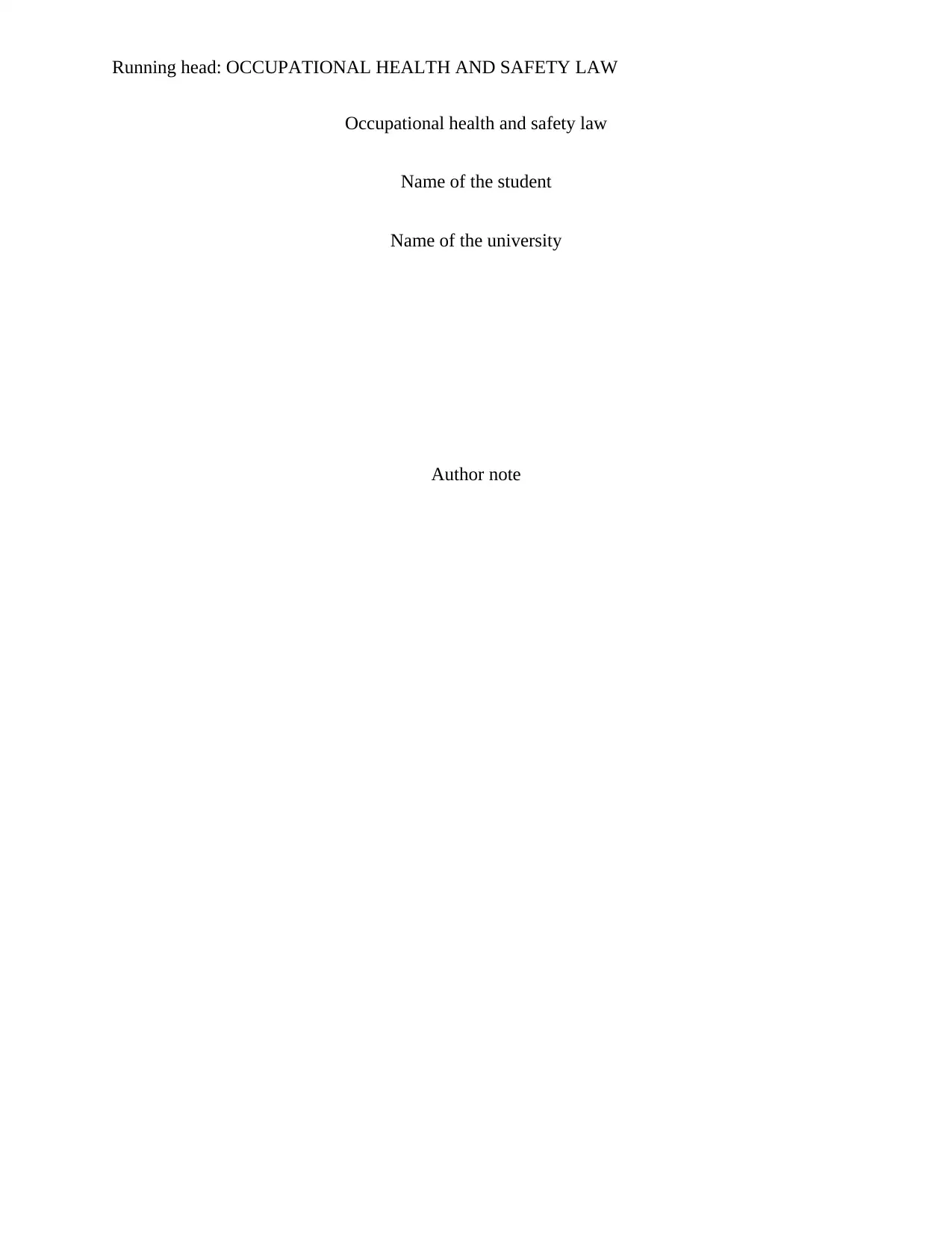
Running head: OCCUPATIONAL HEALTH AND SAFETY LAW
Occupational health and safety law
Name of the student
Name of the university
Author note
Occupational health and safety law
Name of the student
Name of the university
Author note
Paraphrase This Document
Need a fresh take? Get an instant paraphrase of this document with our AI Paraphraser
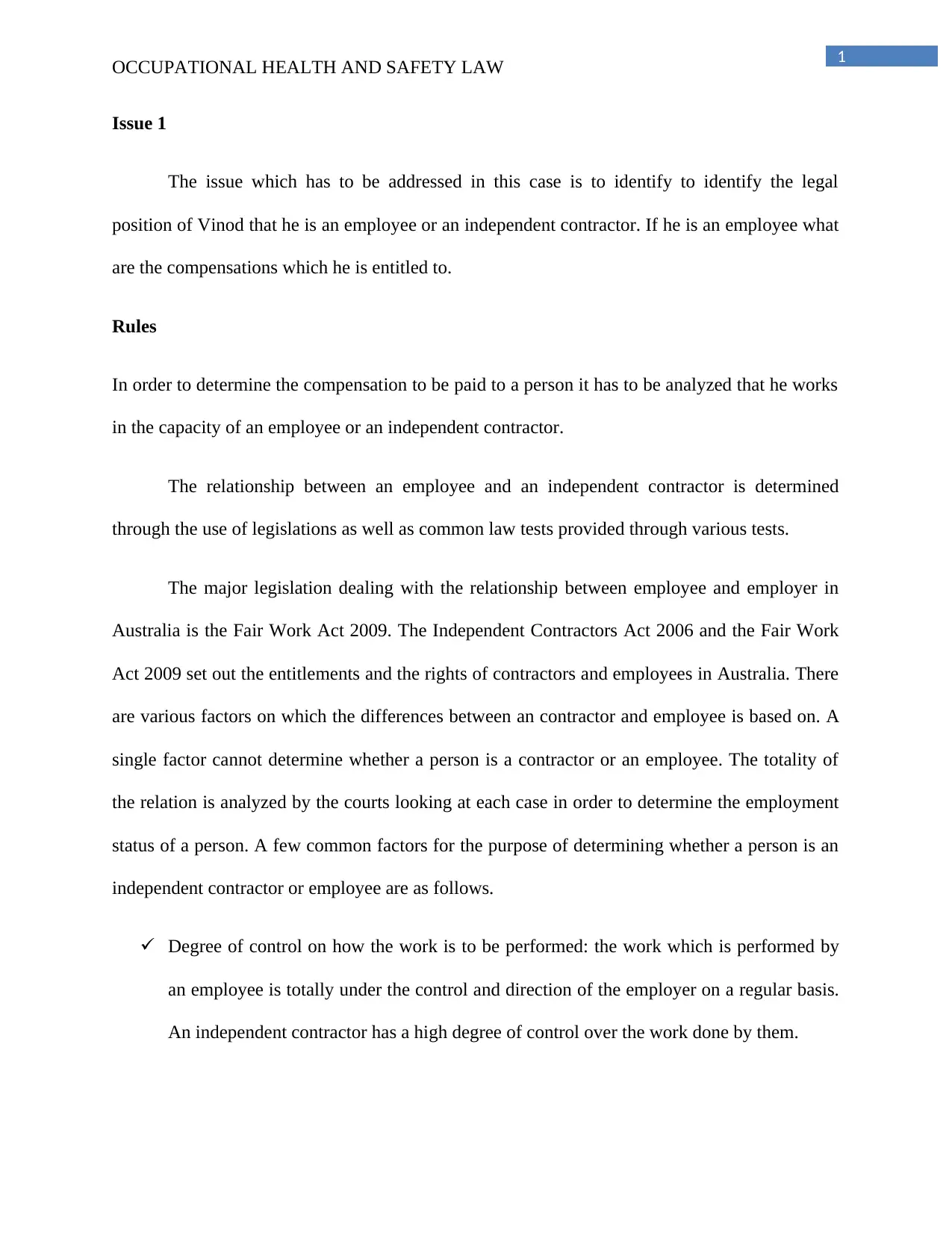
1
OCCUPATIONAL HEALTH AND SAFETY LAW
Issue 1
The issue which has to be addressed in this case is to identify to identify the legal
position of Vinod that he is an employee or an independent contractor. If he is an employee what
are the compensations which he is entitled to.
Rules
In order to determine the compensation to be paid to a person it has to be analyzed that he works
in the capacity of an employee or an independent contractor.
The relationship between an employee and an independent contractor is determined
through the use of legislations as well as common law tests provided through various tests.
The major legislation dealing with the relationship between employee and employer in
Australia is the Fair Work Act 2009. The Independent Contractors Act 2006 and the Fair Work
Act 2009 set out the entitlements and the rights of contractors and employees in Australia. There
are various factors on which the differences between an contractor and employee is based on. A
single factor cannot determine whether a person is a contractor or an employee. The totality of
the relation is analyzed by the courts looking at each case in order to determine the employment
status of a person. A few common factors for the purpose of determining whether a person is an
independent contractor or employee are as follows.
Degree of control on how the work is to be performed: the work which is performed by
an employee is totally under the control and direction of the employer on a regular basis.
An independent contractor has a high degree of control over the work done by them.
OCCUPATIONAL HEALTH AND SAFETY LAW
Issue 1
The issue which has to be addressed in this case is to identify to identify the legal
position of Vinod that he is an employee or an independent contractor. If he is an employee what
are the compensations which he is entitled to.
Rules
In order to determine the compensation to be paid to a person it has to be analyzed that he works
in the capacity of an employee or an independent contractor.
The relationship between an employee and an independent contractor is determined
through the use of legislations as well as common law tests provided through various tests.
The major legislation dealing with the relationship between employee and employer in
Australia is the Fair Work Act 2009. The Independent Contractors Act 2006 and the Fair Work
Act 2009 set out the entitlements and the rights of contractors and employees in Australia. There
are various factors on which the differences between an contractor and employee is based on. A
single factor cannot determine whether a person is a contractor or an employee. The totality of
the relation is analyzed by the courts looking at each case in order to determine the employment
status of a person. A few common factors for the purpose of determining whether a person is an
independent contractor or employee are as follows.
Degree of control on how the work is to be performed: the work which is performed by
an employee is totally under the control and direction of the employer on a regular basis.
An independent contractor has a high degree of control over the work done by them.
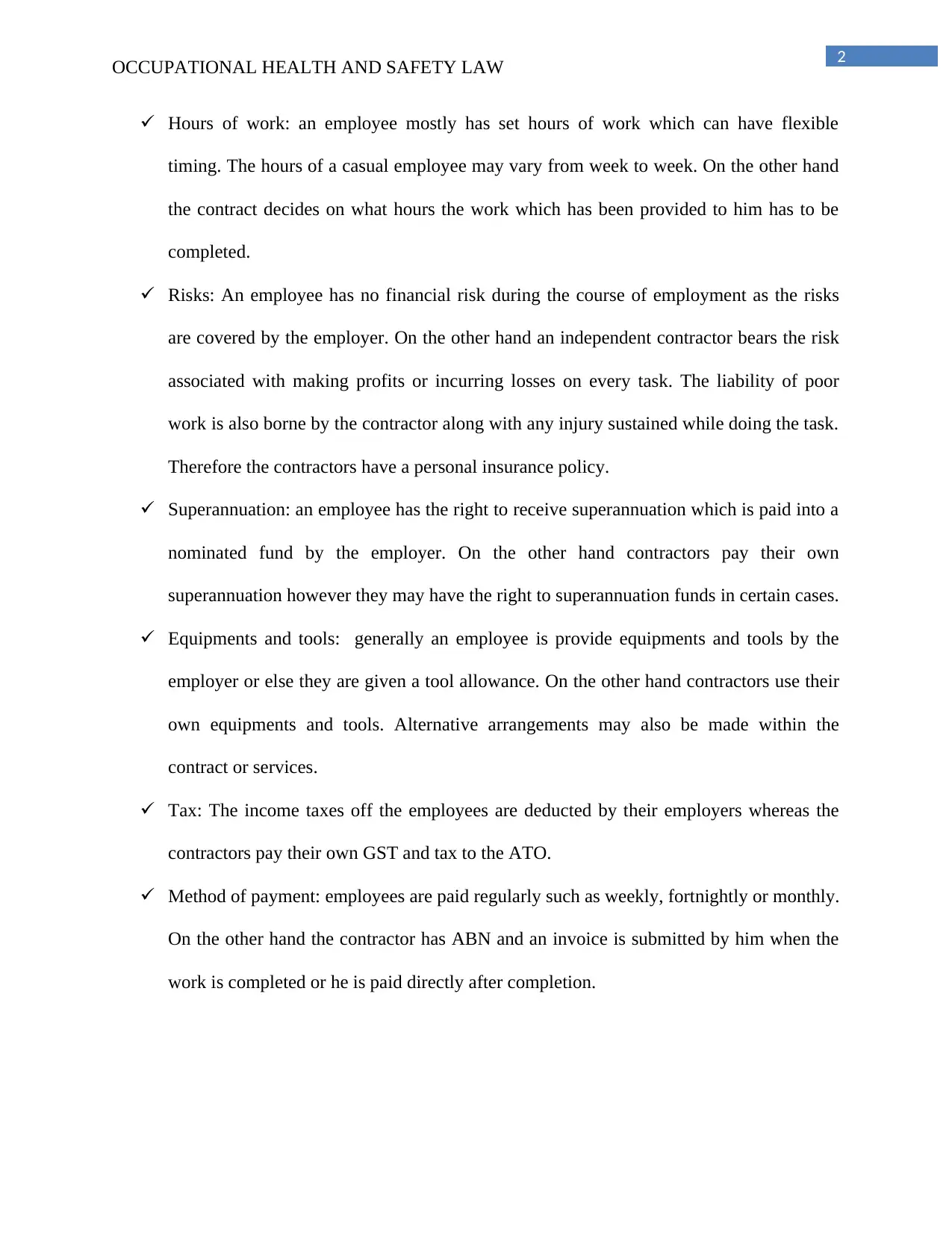
2
OCCUPATIONAL HEALTH AND SAFETY LAW
Hours of work: an employee mostly has set hours of work which can have flexible
timing. The hours of a casual employee may vary from week to week. On the other hand
the contract decides on what hours the work which has been provided to him has to be
completed.
Risks: An employee has no financial risk during the course of employment as the risks
are covered by the employer. On the other hand an independent contractor bears the risk
associated with making profits or incurring losses on every task. The liability of poor
work is also borne by the contractor along with any injury sustained while doing the task.
Therefore the contractors have a personal insurance policy.
Superannuation: an employee has the right to receive superannuation which is paid into a
nominated fund by the employer. On the other hand contractors pay their own
superannuation however they may have the right to superannuation funds in certain cases.
Equipments and tools: generally an employee is provide equipments and tools by the
employer or else they are given a tool allowance. On the other hand contractors use their
own equipments and tools. Alternative arrangements may also be made within the
contract or services.
Tax: The income taxes off the employees are deducted by their employers whereas the
contractors pay their own GST and tax to the ATO.
Method of payment: employees are paid regularly such as weekly, fortnightly or monthly.
On the other hand the contractor has ABN and an invoice is submitted by him when the
work is completed or he is paid directly after completion.
OCCUPATIONAL HEALTH AND SAFETY LAW
Hours of work: an employee mostly has set hours of work which can have flexible
timing. The hours of a casual employee may vary from week to week. On the other hand
the contract decides on what hours the work which has been provided to him has to be
completed.
Risks: An employee has no financial risk during the course of employment as the risks
are covered by the employer. On the other hand an independent contractor bears the risk
associated with making profits or incurring losses on every task. The liability of poor
work is also borne by the contractor along with any injury sustained while doing the task.
Therefore the contractors have a personal insurance policy.
Superannuation: an employee has the right to receive superannuation which is paid into a
nominated fund by the employer. On the other hand contractors pay their own
superannuation however they may have the right to superannuation funds in certain cases.
Equipments and tools: generally an employee is provide equipments and tools by the
employer or else they are given a tool allowance. On the other hand contractors use their
own equipments and tools. Alternative arrangements may also be made within the
contract or services.
Tax: The income taxes off the employees are deducted by their employers whereas the
contractors pay their own GST and tax to the ATO.
Method of payment: employees are paid regularly such as weekly, fortnightly or monthly.
On the other hand the contractor has ABN and an invoice is submitted by him when the
work is completed or he is paid directly after completion.
⊘ This is a preview!⊘
Do you want full access?
Subscribe today to unlock all pages.

Trusted by 1+ million students worldwide
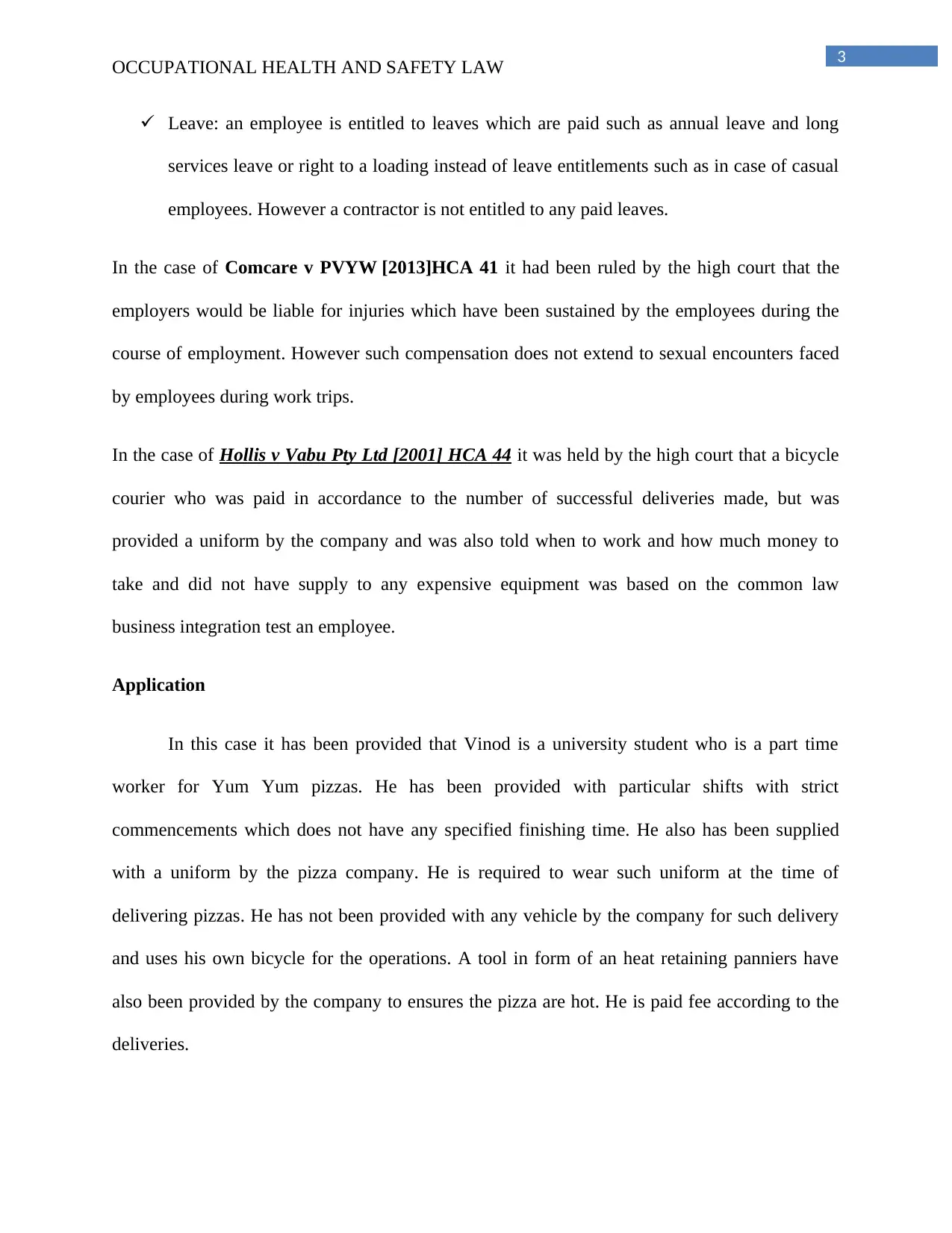
3
OCCUPATIONAL HEALTH AND SAFETY LAW
Leave: an employee is entitled to leaves which are paid such as annual leave and long
services leave or right to a loading instead of leave entitlements such as in case of casual
employees. However a contractor is not entitled to any paid leaves.
In the case of Comcare v PVYW [2013]HCA 41 it had been ruled by the high court that the
employers would be liable for injuries which have been sustained by the employees during the
course of employment. However such compensation does not extend to sexual encounters faced
by employees during work trips.
In the case of Hollis v Vabu Pty Ltd [2001] HCA 44 it was held by the high court that a bicycle
courier who was paid in accordance to the number of successful deliveries made, but was
provided a uniform by the company and was also told when to work and how much money to
take and did not have supply to any expensive equipment was based on the common law
business integration test an employee.
Application
In this case it has been provided that Vinod is a university student who is a part time
worker for Yum Yum pizzas. He has been provided with particular shifts with strict
commencements which does not have any specified finishing time. He also has been supplied
with a uniform by the pizza company. He is required to wear such uniform at the time of
delivering pizzas. He has not been provided with any vehicle by the company for such delivery
and uses his own bicycle for the operations. A tool in form of an heat retaining panniers have
also been provided by the company to ensures the pizza are hot. He is paid fee according to the
deliveries.
OCCUPATIONAL HEALTH AND SAFETY LAW
Leave: an employee is entitled to leaves which are paid such as annual leave and long
services leave or right to a loading instead of leave entitlements such as in case of casual
employees. However a contractor is not entitled to any paid leaves.
In the case of Comcare v PVYW [2013]HCA 41 it had been ruled by the high court that the
employers would be liable for injuries which have been sustained by the employees during the
course of employment. However such compensation does not extend to sexual encounters faced
by employees during work trips.
In the case of Hollis v Vabu Pty Ltd [2001] HCA 44 it was held by the high court that a bicycle
courier who was paid in accordance to the number of successful deliveries made, but was
provided a uniform by the company and was also told when to work and how much money to
take and did not have supply to any expensive equipment was based on the common law
business integration test an employee.
Application
In this case it has been provided that Vinod is a university student who is a part time
worker for Yum Yum pizzas. He has been provided with particular shifts with strict
commencements which does not have any specified finishing time. He also has been supplied
with a uniform by the pizza company. He is required to wear such uniform at the time of
delivering pizzas. He has not been provided with any vehicle by the company for such delivery
and uses his own bicycle for the operations. A tool in form of an heat retaining panniers have
also been provided by the company to ensures the pizza are hot. He is paid fee according to the
deliveries.
Paraphrase This Document
Need a fresh take? Get an instant paraphrase of this document with our AI Paraphraser
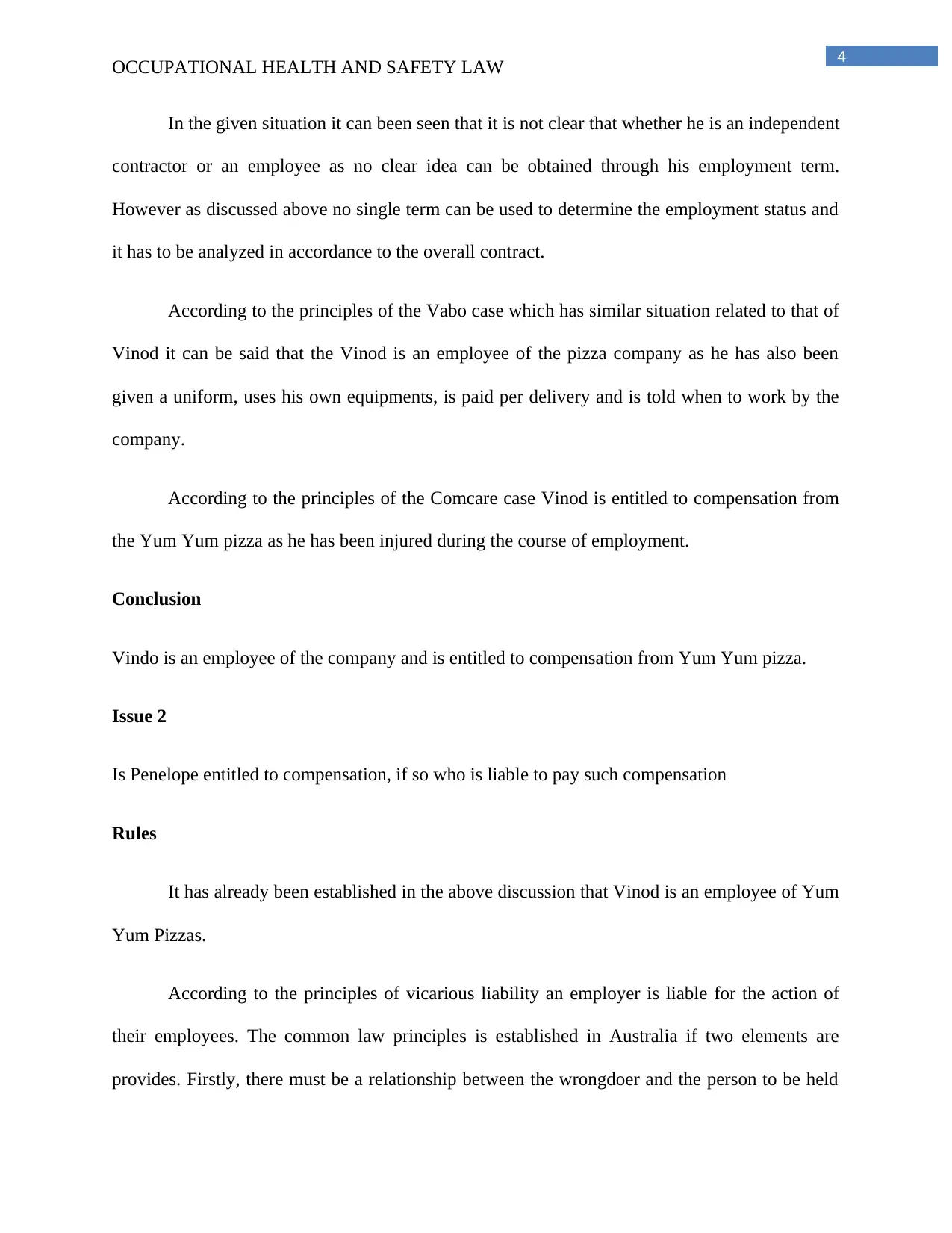
4
OCCUPATIONAL HEALTH AND SAFETY LAW
In the given situation it can been seen that it is not clear that whether he is an independent
contractor or an employee as no clear idea can be obtained through his employment term.
However as discussed above no single term can be used to determine the employment status and
it has to be analyzed in accordance to the overall contract.
According to the principles of the Vabo case which has similar situation related to that of
Vinod it can be said that the Vinod is an employee of the pizza company as he has also been
given a uniform, uses his own equipments, is paid per delivery and is told when to work by the
company.
According to the principles of the Comcare case Vinod is entitled to compensation from
the Yum Yum pizza as he has been injured during the course of employment.
Conclusion
Vindo is an employee of the company and is entitled to compensation from Yum Yum pizza.
Issue 2
Is Penelope entitled to compensation, if so who is liable to pay such compensation
Rules
It has already been established in the above discussion that Vinod is an employee of Yum
Yum Pizzas.
According to the principles of vicarious liability an employer is liable for the action of
their employees. The common law principles is established in Australia if two elements are
provides. Firstly, there must be a relationship between the wrongdoer and the person to be held
OCCUPATIONAL HEALTH AND SAFETY LAW
In the given situation it can been seen that it is not clear that whether he is an independent
contractor or an employee as no clear idea can be obtained through his employment term.
However as discussed above no single term can be used to determine the employment status and
it has to be analyzed in accordance to the overall contract.
According to the principles of the Vabo case which has similar situation related to that of
Vinod it can be said that the Vinod is an employee of the pizza company as he has also been
given a uniform, uses his own equipments, is paid per delivery and is told when to work by the
company.
According to the principles of the Comcare case Vinod is entitled to compensation from
the Yum Yum pizza as he has been injured during the course of employment.
Conclusion
Vindo is an employee of the company and is entitled to compensation from Yum Yum pizza.
Issue 2
Is Penelope entitled to compensation, if so who is liable to pay such compensation
Rules
It has already been established in the above discussion that Vinod is an employee of Yum
Yum Pizzas.
According to the principles of vicarious liability an employer is liable for the action of
their employees. The common law principles is established in Australia if two elements are
provides. Firstly, there must be a relationship between the wrongdoer and the person to be held
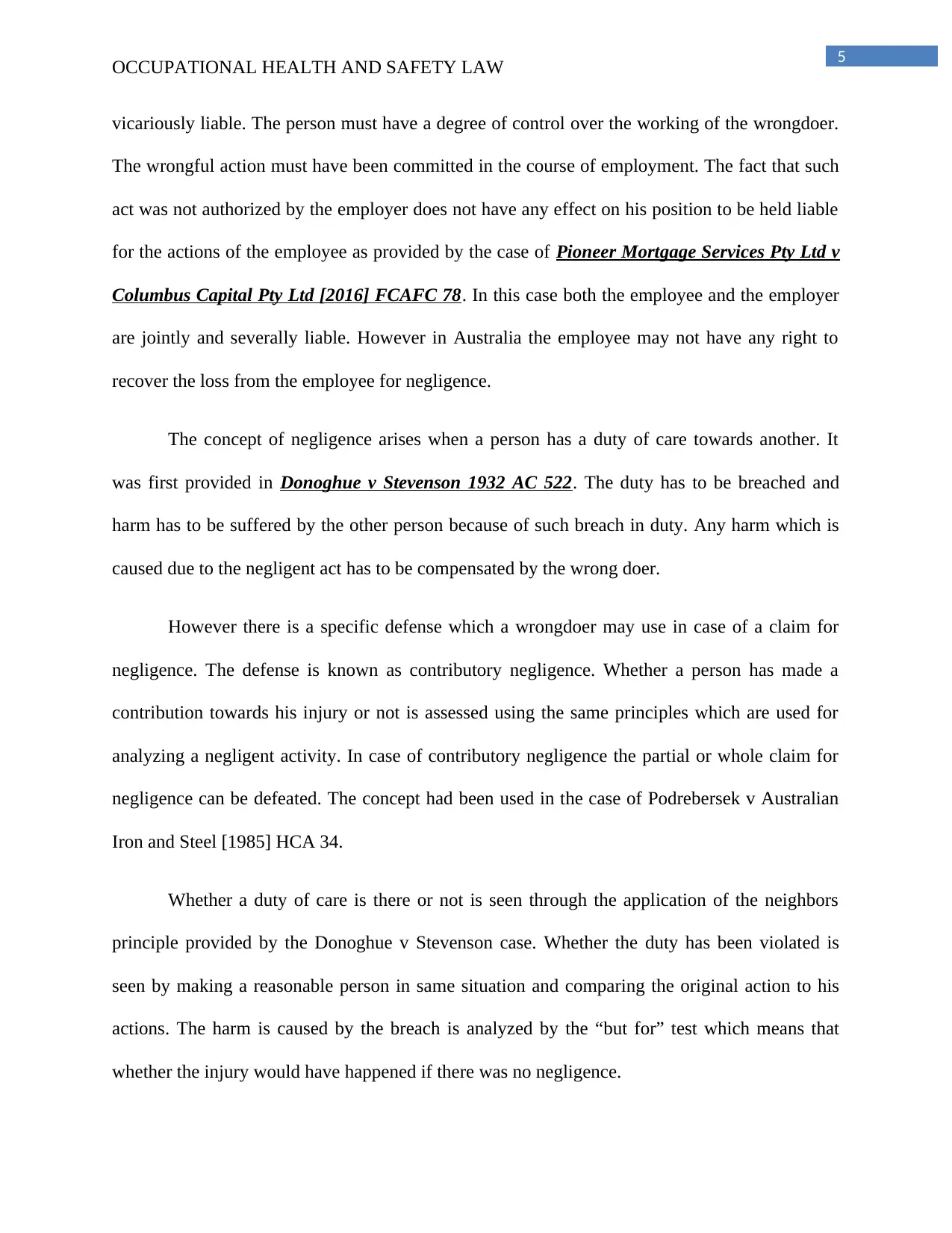
5
OCCUPATIONAL HEALTH AND SAFETY LAW
vicariously liable. The person must have a degree of control over the working of the wrongdoer.
The wrongful action must have been committed in the course of employment. The fact that such
act was not authorized by the employer does not have any effect on his position to be held liable
for the actions of the employee as provided by the case of Pioneer Mortgage Services Pty Ltd v
Columbus Capital Pty Ltd [2016] FCAFC 78. In this case both the employee and the employer
are jointly and severally liable. However in Australia the employee may not have any right to
recover the loss from the employee for negligence.
The concept of negligence arises when a person has a duty of care towards another. It
was first provided in Donoghue v Stevenson 1932 AC 522. The duty has to be breached and
harm has to be suffered by the other person because of such breach in duty. Any harm which is
caused due to the negligent act has to be compensated by the wrong doer.
However there is a specific defense which a wrongdoer may use in case of a claim for
negligence. The defense is known as contributory negligence. Whether a person has made a
contribution towards his injury or not is assessed using the same principles which are used for
analyzing a negligent activity. In case of contributory negligence the partial or whole claim for
negligence can be defeated. The concept had been used in the case of Podrebersek v Australian
Iron and Steel [1985] HCA 34.
Whether a duty of care is there or not is seen through the application of the neighbors
principle provided by the Donoghue v Stevenson case. Whether the duty has been violated is
seen by making a reasonable person in same situation and comparing the original action to his
actions. The harm is caused by the breach is analyzed by the “but for” test which means that
whether the injury would have happened if there was no negligence.
OCCUPATIONAL HEALTH AND SAFETY LAW
vicariously liable. The person must have a degree of control over the working of the wrongdoer.
The wrongful action must have been committed in the course of employment. The fact that such
act was not authorized by the employer does not have any effect on his position to be held liable
for the actions of the employee as provided by the case of Pioneer Mortgage Services Pty Ltd v
Columbus Capital Pty Ltd [2016] FCAFC 78. In this case both the employee and the employer
are jointly and severally liable. However in Australia the employee may not have any right to
recover the loss from the employee for negligence.
The concept of negligence arises when a person has a duty of care towards another. It
was first provided in Donoghue v Stevenson 1932 AC 522. The duty has to be breached and
harm has to be suffered by the other person because of such breach in duty. Any harm which is
caused due to the negligent act has to be compensated by the wrong doer.
However there is a specific defense which a wrongdoer may use in case of a claim for
negligence. The defense is known as contributory negligence. Whether a person has made a
contribution towards his injury or not is assessed using the same principles which are used for
analyzing a negligent activity. In case of contributory negligence the partial or whole claim for
negligence can be defeated. The concept had been used in the case of Podrebersek v Australian
Iron and Steel [1985] HCA 34.
Whether a duty of care is there or not is seen through the application of the neighbors
principle provided by the Donoghue v Stevenson case. Whether the duty has been violated is
seen by making a reasonable person in same situation and comparing the original action to his
actions. The harm is caused by the breach is analyzed by the “but for” test which means that
whether the injury would have happened if there was no negligence.
⊘ This is a preview!⊘
Do you want full access?
Subscribe today to unlock all pages.

Trusted by 1+ million students worldwide
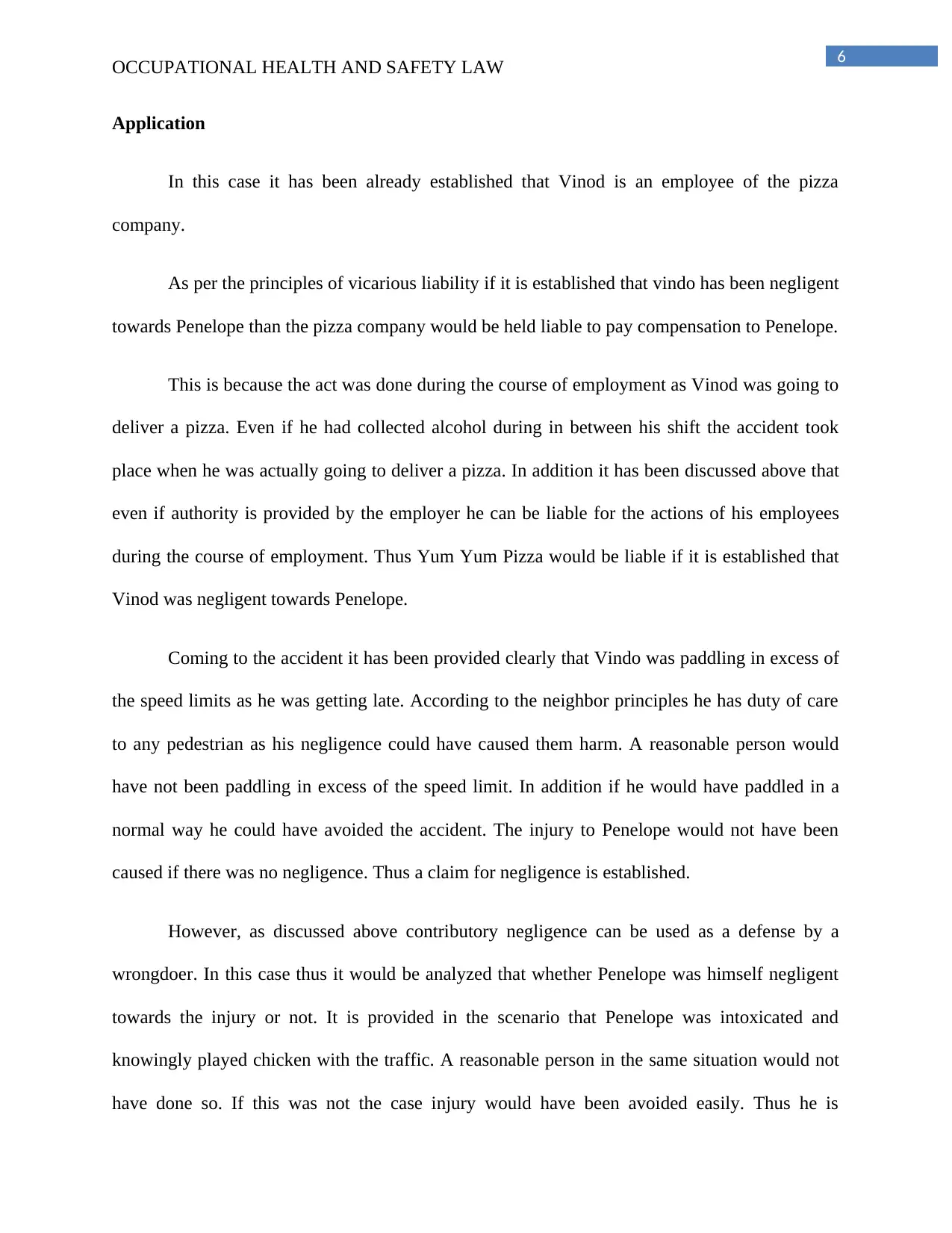
6
OCCUPATIONAL HEALTH AND SAFETY LAW
Application
In this case it has been already established that Vinod is an employee of the pizza
company.
As per the principles of vicarious liability if it is established that vindo has been negligent
towards Penelope than the pizza company would be held liable to pay compensation to Penelope.
This is because the act was done during the course of employment as Vinod was going to
deliver a pizza. Even if he had collected alcohol during in between his shift the accident took
place when he was actually going to deliver a pizza. In addition it has been discussed above that
even if authority is provided by the employer he can be liable for the actions of his employees
during the course of employment. Thus Yum Yum Pizza would be liable if it is established that
Vinod was negligent towards Penelope.
Coming to the accident it has been provided clearly that Vindo was paddling in excess of
the speed limits as he was getting late. According to the neighbor principles he has duty of care
to any pedestrian as his negligence could have caused them harm. A reasonable person would
have not been paddling in excess of the speed limit. In addition if he would have paddled in a
normal way he could have avoided the accident. The injury to Penelope would not have been
caused if there was no negligence. Thus a claim for negligence is established.
However, as discussed above contributory negligence can be used as a defense by a
wrongdoer. In this case thus it would be analyzed that whether Penelope was himself negligent
towards the injury or not. It is provided in the scenario that Penelope was intoxicated and
knowingly played chicken with the traffic. A reasonable person in the same situation would not
have done so. If this was not the case injury would have been avoided easily. Thus he is
OCCUPATIONAL HEALTH AND SAFETY LAW
Application
In this case it has been already established that Vinod is an employee of the pizza
company.
As per the principles of vicarious liability if it is established that vindo has been negligent
towards Penelope than the pizza company would be held liable to pay compensation to Penelope.
This is because the act was done during the course of employment as Vinod was going to
deliver a pizza. Even if he had collected alcohol during in between his shift the accident took
place when he was actually going to deliver a pizza. In addition it has been discussed above that
even if authority is provided by the employer he can be liable for the actions of his employees
during the course of employment. Thus Yum Yum Pizza would be liable if it is established that
Vinod was negligent towards Penelope.
Coming to the accident it has been provided clearly that Vindo was paddling in excess of
the speed limits as he was getting late. According to the neighbor principles he has duty of care
to any pedestrian as his negligence could have caused them harm. A reasonable person would
have not been paddling in excess of the speed limit. In addition if he would have paddled in a
normal way he could have avoided the accident. The injury to Penelope would not have been
caused if there was no negligence. Thus a claim for negligence is established.
However, as discussed above contributory negligence can be used as a defense by a
wrongdoer. In this case thus it would be analyzed that whether Penelope was himself negligent
towards the injury or not. It is provided in the scenario that Penelope was intoxicated and
knowingly played chicken with the traffic. A reasonable person in the same situation would not
have done so. If this was not the case injury would have been avoided easily. Thus he is
Paraphrase This Document
Need a fresh take? Get an instant paraphrase of this document with our AI Paraphraser
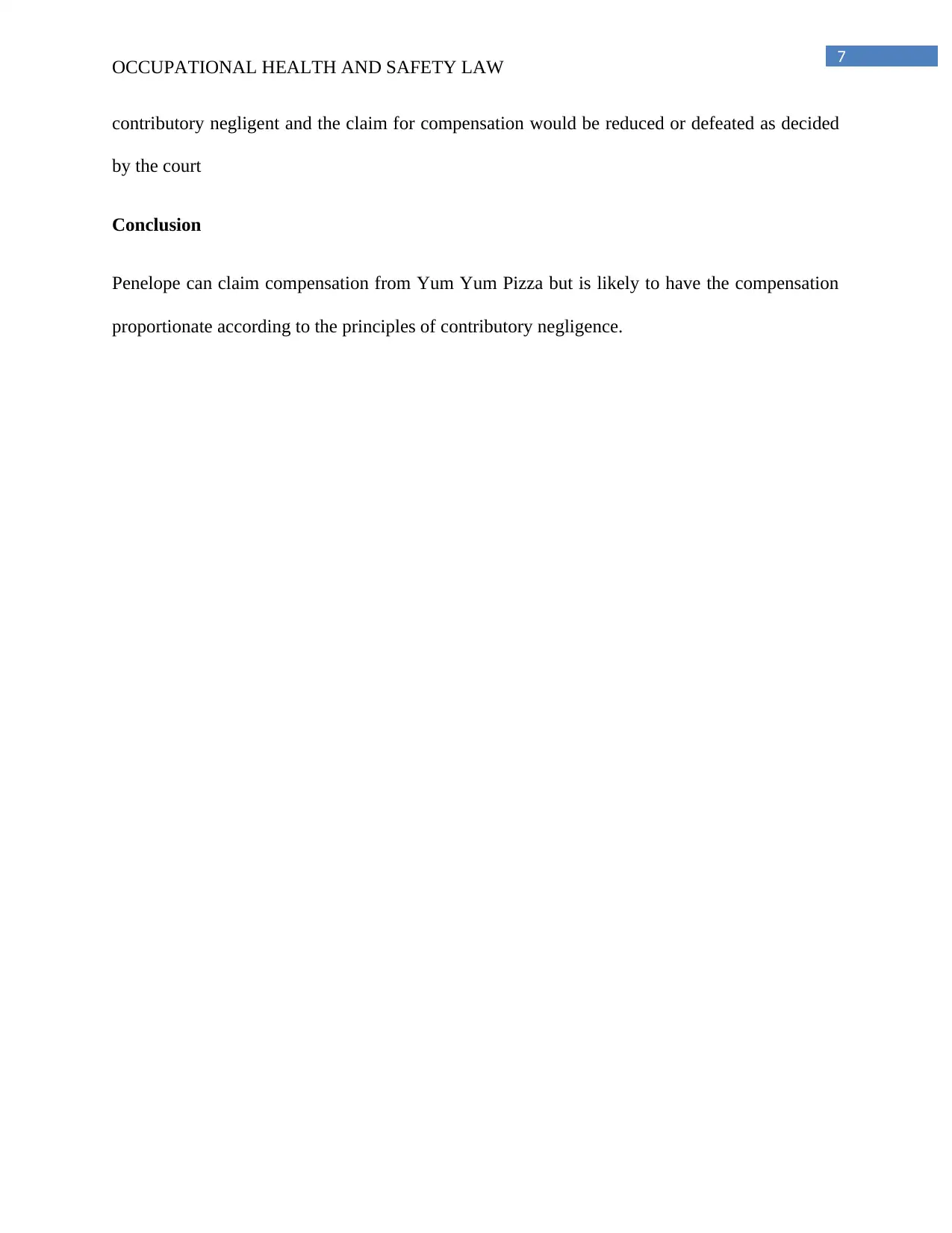
7
OCCUPATIONAL HEALTH AND SAFETY LAW
contributory negligent and the claim for compensation would be reduced or defeated as decided
by the court
Conclusion
Penelope can claim compensation from Yum Yum Pizza but is likely to have the compensation
proportionate according to the principles of contributory negligence.
OCCUPATIONAL HEALTH AND SAFETY LAW
contributory negligent and the claim for compensation would be reduced or defeated as decided
by the court
Conclusion
Penelope can claim compensation from Yum Yum Pizza but is likely to have the compensation
proportionate according to the principles of contributory negligence.
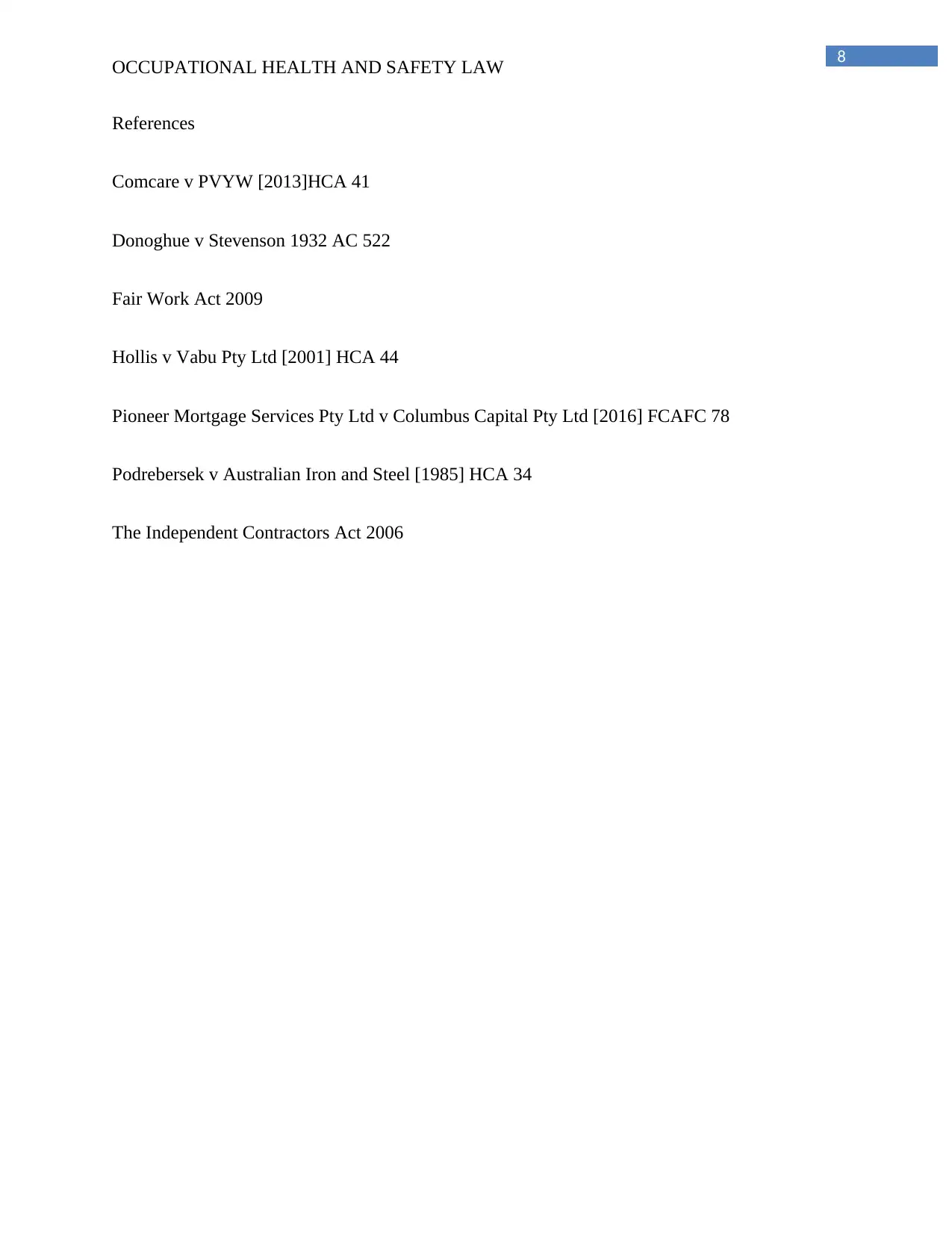
8
OCCUPATIONAL HEALTH AND SAFETY LAW
References
Comcare v PVYW [2013]HCA 41
Donoghue v Stevenson 1932 AC 522
Fair Work Act 2009
Hollis v Vabu Pty Ltd [2001] HCA 44
Pioneer Mortgage Services Pty Ltd v Columbus Capital Pty Ltd [2016] FCAFC 78
Podrebersek v Australian Iron and Steel [1985] HCA 34
The Independent Contractors Act 2006
OCCUPATIONAL HEALTH AND SAFETY LAW
References
Comcare v PVYW [2013]HCA 41
Donoghue v Stevenson 1932 AC 522
Fair Work Act 2009
Hollis v Vabu Pty Ltd [2001] HCA 44
Pioneer Mortgage Services Pty Ltd v Columbus Capital Pty Ltd [2016] FCAFC 78
Podrebersek v Australian Iron and Steel [1985] HCA 34
The Independent Contractors Act 2006
⊘ This is a preview!⊘
Do you want full access?
Subscribe today to unlock all pages.

Trusted by 1+ million students worldwide
1 out of 9
Related Documents
Your All-in-One AI-Powered Toolkit for Academic Success.
+13062052269
info@desklib.com
Available 24*7 on WhatsApp / Email
![[object Object]](/_next/static/media/star-bottom.7253800d.svg)
Unlock your academic potential
Copyright © 2020–2025 A2Z Services. All Rights Reserved. Developed and managed by ZUCOL.





